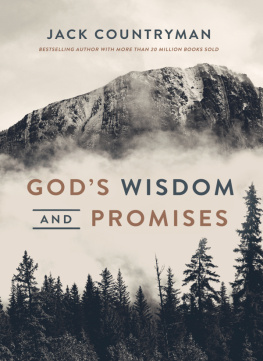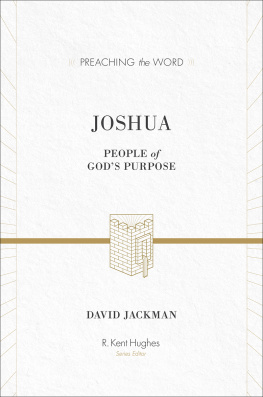What the Bible Is All About Study Series: Entering Into the Promise: Joshua1 & 2 Samuel
Visit Tyndale online at www.tyndale.com.
Copyright 2014 by Gospel Light. Copyright assigned to Tyndale House Publishers, Inc., 2015. All rights reserved.
All Scripture quotations, unless otherwise indicated, are taken from the Holy Bible, New International Version,NIV. Copyright 1973, 1978, 1984, 2011 by Biblica, Inc. Used by permission. All rights reserved worldwide.
Other versions used are:
ASVScripture quotations are taken from The Holy Bible, American Standard Version.
CEVScripture taken from the Contemporary English Version, copyright 1991, 1992, 1995 by American Bible Society. Used by permission.
ESVScripture quotations are taken from The Holy Bible, English Standard Version (ESV), copyright 2001 by Crossway, a publishing ministry of Good News Publishers. Used by permission. All rights reserved.
KJVScripture quotations are taken from the Holy Bible, King James Version.
NASBScripture taken from the New American Standard Bible, copyright 1960, 1962, 1963, 1968, 1971, 1972, 1973, 1975, 1977, 1995 by The Lockman Foundation. Used by permission.
NKJVScripture taken from the New King James Version, copyright 1982 by Thomas Nelson, Inc. Used by permission. All rights reserved.
NLTScripture quotations marked NLT are taken from the Holy Bible, New Living Translation, copyright 1996, 2004, 2015 by Tyndale House Foundation. Used by permission of Tyndale House Publishers, Inc., Carol Stream, Illinois 60188. All rights reserved.
TYNDALE, Tyndales quill logo, and What the Bible Is All About are registered trademarks of Tyndale House Publishers, Inc.
ISBN 978-1-4964-1635-3
C ONTENTS
Setting the Stage for Conquest
Preparing for Battle (Joshua 12)
The Attack on Jericho and Ai (Joshua 38)
Further Campaigns and Dividing the Territory (Joshua 924)
The Rise of the Judges (Judges 13:6)
Seven Cycles of Failure (Judges 3:716)
The Bloodline of a King (Judges 1721; Ruth 14)
The Last of the Judges (1 Samuel 18)
A Rocky Start for the New Rule (1 Samuel 917)
The Trials of David (1 Samuel 1831)
Davids Unification of Israel (2 Samuel 110)
Trouble in Davids Reign (2 Samuel 1124)
The Question of Holy War
H OW TO USE THIS STUDY
In Entering into the Promise, based on Dr. Henrietta Mearss What the Bible Is All About, you will study the Israelites conquest of the Promised Land in the book of Joshua and the trials and challenges the new nation faced in the books of Judges through 2 Samuel. During the 12 sessions in this study, you will gain a better understanding of how the Israelites took possession of the land, how God established judges (or shopets) to lead the people, how they rejected this structure in favor of a king, and how God used David (and Solomon) to establish Israel as a mighty nation.
Each session begins with an overview of the material that includes the following:
- Session Focus: Explains the main theme of the portion of the Bible being examined.
- Key Verses to Memorize: Important passages of Scripture that you may want to commit to heart. As Joshua 1:8 states, Keep this Book of the Law always on your lips; meditate on it day and night, so that you may be careful to do everything written in it. Then you will be prosperous and successful.
- Weekly Reading: A listing of the chapters in the Bible that will be covered during the session and a suggested breakdown for how to read the material during a five-day period.
- Session at a Glance: Provides an outline for leaders on how to structure the material in a group setting (both 60-minute and 90-minute options are provided).
Before beginning each session, it is recommended that you read the portions of Scripture listed in the weekly reading section of the overview. At the end of each session, you will find a number of personal application and study questions based on these chapters in the Bible and on the background material presented in that sessions reading. These questions have been written to allow you to reflect on the material and apply the ideas presented in the session to your life. You can answer these questions individually or incorporate them as part of a small-group discussion.
P REFACE

READING THE BIBLE AS IT WAS MEANT TO BE READ
Dr. Henrietta C. Mears
Dr. Henrietta C. Mears was the director of Christian Education at Hollywood Presbyterian Church for many years and the founder of Gospel Light Publications, Gospel Light Worldwide, and the Forest Home Christian Conference Center in the San Bernardino Mountains of California. In this capacity, Mears put together a highly successful three-year high school curriculum on the whole Bible, which serves as the foundation for this study guide series.
Mears was a modern-day champion of the Christo-centric interpretation of the Bible, whereby Christ is considered to be the center of all the themes of both the Old and New Testaments. At a time when others were centered on historicism, the evolution of the idea of monotheism, genre studies or the study of the communities out of which certain writings were presumed to arise, Henrietta steadfastly kept the focus on Jesus. In this persistent attention to the centrality of Jesus Christ, Henrietta was in good company: This same impulse has been found in the best thinkers of the Church throughout the centuriesincluding Augustine, Basil the Great and John Chrysostomand it had its start in the Bible itself.
The following is an original article by Dr. Henrietta C. Mears titled The Bible: Christo-centric. Read it carefullyit packs a lot of punch!
The Bible: Christo-centric
There is one principal subject of the Bible to which every other subject is related. The Bible is Christo-centric. Take Christ out of the Old Testament and the whole structure falls apart. The Book, from Genesis to Revelation, has but one themethe Bible speaks only of Jesus Christ. You remember Paul said to the Corinthians, I determined not to know any thing among you, save Jesus Christ, and Him crucified (1 Corinthians 2:2). That is the theme of the Bible from beginning to end.
THE KEY THAT UNLOCKS
The subject of the Old Testament is the same as the New. Each complements the other. Neither is complete without the other. They both are the witness that God has borne concerning His Son (1 John 5:9, ASV). No one can ever understand the Bible unless he sees Christ on every page. He is the One who solves the difficulties in interpretation. He is the key that unlocks every page.
There is a story told of some knights coming to an old castle. The gate was closed and locked. How they wished they could get within the walls, but they could not climb over them. They found a bunch of keys, and eagerly tried each one. How they worked and struggled, but the gate did not respond. Finally, they put in one of the keys, and the great lock came open without the slightest difficulty. Do you suppose those men doubted for a moment that they had found the right key?
This old story reminds us of men going to the Bible. It seems like a Book of Mystery to them. They have tried every key to open it, but every key has failed. The key of mans wisdom has been tried to unlock its treasures, but without success. There is, however, one key that even the humblest can put into the lock, and with Him the gate of understanding opens. Shall we doubt then that Christ is the right key? He is more than the key. He says, I am the Way, and the Truth (John 14:6).













